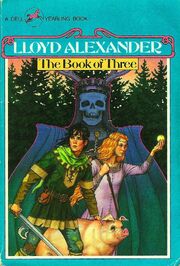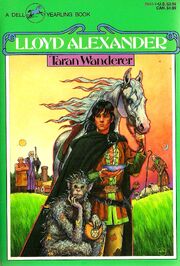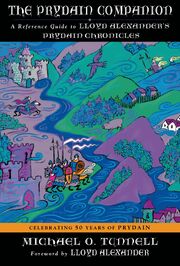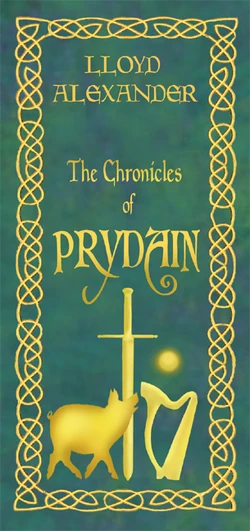No edit summary |
|||
| (12 intermediate revisions by 2 users not shown) | |||
| Line 1: | Line 1: | ||
| − | |||
[[File:Prydain_spine.jpg|250px|left]] |
[[File:Prydain_spine.jpg|250px|left]] |
||
| − | '''''The Chronicles of Prydain''''' are a series of |
+ | '''''The Chronicles of Prydain''''' are a series of high fantasy novels written by Philadelphia native [[Lloyd Alexander]], and published annually by Holt, Rhinehart and Winston from 1964 to 1968. Originally intended for children and young adults, the series remains popular among readers of all ages, many of whom consider the series to be on par with Tolkien's ''The Lord of the Rings''. |
| ⚫ | |||
| ⚫ | The five novels and eight short stories in the ''Prydain'' series were inspired by medieval Welsh legends and |
||
| + | :'''1.''' ''[[The Book of Three (novel)|The Book of Three]]'' |
||
| + | :'''2.''' ''[[The Black Cauldron (novel)|The Black Cauldron]]'' |
||
| + | :'''3.''' ''[[The Castle of Llyr]]'' |
||
| + | :'''4.''' ''[[Taran Wanderer]]'' |
||
| + | :'''5.''' ''[[The High King]]'' |
||
| + | :'''6.''' ''[[The Foundling and Other Tales of Prydain]]'' |
||
| ⚫ | The five novels and eight short stories in the ''Prydain'' series were inspired by medieval Welsh legends and folktales, some of which are collected in the so-called [[Mabinogion|''Mabinogion'']] or the [[Welsh Triads]]. Mr. Alexander drew names and atmosphere from these texts, then went on to create wholly unique and original characters, stories, places and concepts, independent of the medieval literature. |
||
| ⚫ | The short stories, now collected in ''[[The Foundling and Other Tales of Prydain]]'', were originally published in three volumes: two picture books and one collection. They act as backstories which fill in gaps for minor characters.<sup> </sup>The [http://en.wikipedia.org/wiki/Internet_Speculative_Fiction_Database Internet Speculative Fiction Database] catalogs all Prydain publications, Alexander's fiction and |
||
| + | |||
| ⚫ | The short stories, now collected in ''[[The Foundling and Other Tales of Prydain]]'', were originally published in three volumes: two picture books and one collection. They act as backstories which fill in gaps for minor characters.<sup> </sup>The [http://en.wikipedia.org/wiki/Internet_Speculative_Fiction_Database Internet Speculative Fiction Database] catalogs all Prydain publications, Alexander's fiction and ''The Prydain Companion'' by Michael O. Tunnell, as the "''Prydain'' series". A nearly complete omnibus edition of the fiction was published in 1991 as '''''The Prydain Chronicles'''''. |
||
==Setting and Summary== |
==Setting and Summary== |
||
| + | [[File:Wales-lake-valley.jpg|thumb|right|497px|The country of Wales, part of the United Kingdom, located in the west of the island of Great Britain.]] |
||
The setting of the ''Chronicles'' is the [[Prydain|Land of Prydain]], an ancient country of many small kingdoms, in which [[Magic|enchantment]] abounds and "evil is never far". The main character is [[Taran|Taran of Caer Dallben]], a sometimes rash young man who dreams of being a hero, and who strives to be honorable through his many adventures. Taran's [[Companions]] include the lovely and outspoken [[Princess Eilonwy]], the impetuous bard [[Fflewddur Fflam]], the shaggy creature [[Gurgi]], and the noble warrior [[Gwydion|Prince Gwydion Son of Don]]. Other essential characters include [[Dallben]] the Enchanter, [[Doli]] of the [[Fair Folk]], and the oracular pig [[Hen Wen]]. The series narrates their several quests and conflicts, including the struggle to defeat [[Arawn Death-Lord]] and his many allies, servants and creatures. Among these are the enchantress [[Achren]], the fierce [[Huntsmen of Annuvin]], and the deathless [[Cauldron-Born]] warriors. |
The setting of the ''Chronicles'' is the [[Prydain|Land of Prydain]], an ancient country of many small kingdoms, in which [[Magic|enchantment]] abounds and "evil is never far". The main character is [[Taran|Taran of Caer Dallben]], a sometimes rash young man who dreams of being a hero, and who strives to be honorable through his many adventures. Taran's [[Companions]] include the lovely and outspoken [[Princess Eilonwy]], the impetuous bard [[Fflewddur Fflam]], the shaggy creature [[Gurgi]], and the noble warrior [[Gwydion|Prince Gwydion Son of Don]]. Other essential characters include [[Dallben]] the Enchanter, [[Doli]] of the [[Fair Folk]], and the oracular pig [[Hen Wen]]. The series narrates their several quests and conflicts, including the struggle to defeat [[Arawn Death-Lord]] and his many allies, servants and creatures. Among these are the enchantress [[Achren]], the fierce [[Huntsmen of Annuvin]], and the deathless [[Cauldron-Born]] warriors. |
||
| − | |||
| − | ==Books== |
||
| ⚫ | |||
| − | [[File:Book_of_three1.jpg|left|thumb|'''1.''' ''[[The Book of Three (novel)|The Book of Three]]'' – Taran and companions race to report news of an army raised by the Horned King, an evil war leader of Arawn Death-Lord.]][[File:Black_Cauldron3.jpg|center|thumb|'''2.''' ''[[The Black Cauldron (novel)|The Black Cauldron]]'' – Taran and companions struggle to capture a magical cauldron that generates Arawn's deathless army.]] |
||
| − | [[File:Castleofllyr.jpg|left|thumb|'''3.''' ''[[The Castle of Llyr]]'' – Taran escorts Eilonwy to a royal island court for her education, where she is kidnapped; he leads a band to rescue her.]] |
||
| − | [[File:Taran_Wanderer2.jpg|center|thumb|'''4.''' ''[[Taran Wanderer]]'' – Taran searches for his identity, parentage and wisdom.]] |
||
| − | [[File:The_high_king.jpg|left|thumb|'''5.''' ''[[The High King]]'' – Taran and companions join Prydain's great effort finally to defeat Arawn Death-Lord.]]<br /> <br /> <br /> <br /> |
||
| − | [[File:Thefoundling.jpg|center|thumb|''[[The Foundling and Other Tales of Prydain]]'' is a collection of eight short stories, companion tales to the series.]] |
||
==Development and Inspiration== |
==Development and Inspiration== |
||
| − | In terms of setting and subject matter, the ''Prydain'' novels draw from [http://en.wikipedia.org/wiki/Wales Welsh] [http://en.wikipedia.org/wiki/Welsh_mythology legend], particularly |
+ | [[File:Book_of_Three_Flip.jpg|left|thumb|'''1.''' Taran and companions race to report news of an army raised by the Horned King, an evil war leader of Arawn Death-Lord.]][[File:The_Black_Cauldron.jpg|right|thumb|'''2.''' Taran and companions struggle to capture a magical cauldron that generates Arawn's deathless army.]][[File:The_castle_of_llyr.jpg|left|thumb|'''3.''' Taran escorts Eilonwy to a royal island court for her education, where she is kidnapped; he leads a band to rescue her.]][[File:Taran-wanderer-tp.jpg|right|thumb|'''4.''' Taran searches for his identity, parentage and wisdom.]][[File:The_high_king.jpg|left|thumb|'''5.''' Taran and companions join Prydain's great effort finally to defeat Arawn Death-Lord.]] [[File:TF1.JPG|right|thumb|'''6.''' A collection of eight short stories, companion and background tales to the series.]]In terms of setting and subject matter, the ''Prydain'' novels draw from [http://en.wikipedia.org/wiki/Wales Welsh] [http://en.wikipedia.org/wiki/Welsh_mythology legend], particularly tales of King Arthur and the ''[[Mabinogion]]''.<sup> </sup>The books are not, however, retellings of those legends, a point Alexander himself makes in the Author's Note to ''The Book of Three'': stories have been conflated and altered, and characters have been changed in both role and motive. A student of Welsh culture should be prepared as [http://en.wikipedia.org/wiki/Arawn Arawn] -- an honorable king in the source tales -- becomes the books' dark arch enemy, while [http://en.wikipedia.org/wiki/Gwydion Gwydion] ab Don's ruthless traits in the source tales are replaced in Alexander's Prydain by unclouded heroism. |
| − | + | In the Note, Alexander further reveals that the land's terrain is derived from Wales, but he goes on to clarify that Prydain is separate from Wales in both geography and history. |
|
| − | Alexander |
+ | Alexander was "always interested in mythology". From a young age he read tales of King Arthur's knights; later, while receiving [http://en.wikipedia.org/wiki/Military_intelligence#Tactical_intelligence combat intelligence] training in Wales during [http://en.wikipedia.org/wiki/World_War_II World War II], he half-expected armored horsemen to come riding out of the various ruined castles he saw dotting the landscape. This exposure to the scenery, culture and language of Wales became "part of the raw material for the Prydain books".[[File:JL_CoP.jpg|left|thumb|The 1991 omnibus edition.]][[File:TPC_HH.jpg|right|thumb|Michael O. Tunnell's encyclopedic ''The Prydain Companion'']] |
Initially Alexander "planned to write one or two [Prydain books] – three at the very most". He and his editor Ann Durell planned a trilogy with titles ''The Battle of the Trees'', ''The Lion with the Steady Hand'', and ''Little Gwion''. The series as a whole would have been called ''The Sons of Llyr'', and would have represented a "closer retelling of stories from Celtic mythology"<sup>1</sup>. |
Initially Alexander "planned to write one or two [Prydain books] – three at the very most". He and his editor Ann Durell planned a trilogy with titles ''The Battle of the Trees'', ''The Lion with the Steady Hand'', and ''Little Gwion''. The series as a whole would have been called ''The Sons of Llyr'', and would have represented a "closer retelling of stories from Celtic mythology"<sup>1</sup>. |
||
| − | Alexander wrote the first book around a framework derived from from events described in the ''Cad Goddeu'' (English: [http://en.wikipedia.org/wiki/Gwydion#The_Battle_of_the_Trees "The Battle of the Trees"), a medieval Welsh poem preserved in the 14th-century manuscript known as the Book of Taliesin. More specifically, Alexander drew the plot from a summary preserved in Peniarth MS 98B (late 16th century), describing a battle between Gwydion and Arawn. Gwydion ultimately triumphed by guessing the name of one of Arawn's men, Bran (possibly Bran the Blessed). |
+ | Alexander wrote the first book around a framework derived from from events described in the ''Cad Goddeu'' (English: [http://en.wikipedia.org/wiki/Gwydion#The_Battle_of_the_Trees "The Battle of the Trees"]), a medieval Welsh poem preserved in the 14th-century manuscript known as the Book of Taliesin. More specifically, Alexander drew the plot from a summary preserved in Peniarth MS 98B (late 16th century), describing a battle between Gwydion and Arawn. According to Alexander's sources, Gwydion ultimately triumphed by guessing the name of one of Arawn's men, Bran (possibly Bran the Blessed), from the use of alder branches on his shield device. |
| − | At one stage of writing the battle occurred |
+ | At one stage of writing the battle occurred earlier in the book and was described in greater detail. Later, after the scene had been largely deleted from the text (it survives as the partially-glimpsed backdrop to the climax), a number of different titles were suggested, including ''The Assistant Pig-Keeper'' from Durell and ''The Burning Blade'' from Alexander. An art director at Holt, Nonny Hogrogian, suggested ''The Book of Three''. Soon afterwards, just prior to publication, Alexander decided on a title for the entire series: ''The Chronicles of Prydain''. |
| + | Later, after ''The Black Cauldron'' had been written, Alexander started work on the third and at that time final volume of the series, ''The High King of Prydain''. Sensing that something was missing he conceived and wrote ''The Castle of Llyr'' and inserted that narrative into the ''Chronicles''. (At this time he also undertook the writing of the first two short stories in the series, "Coll and His White Pig" and "The Truthful Harp", which were initially published as separate picture-book titles illustrated by Evaline Ness.) |
||
| − | Soon afterwards, Alexander decided on a title for the series: ''The Chronicles of Prydain''. |
||
| − | + | It was then Durell who felt that something was missing between the third and fourth volumes. While ''The High King'' referred to Taran's past experiences, the editor wanted to know more details, and suspected readers would feel the same. So ''Taran Wanderer'', written last, became the fourth book and ''The High King'' -- after a rewrite to reflect the additional material -- became the fifth and final installment in the five-volume series. |
|
| − | + | 1. Tunnell, Michael O. ''The Prydain Companion'', Henry Holt and Company, 2003. pp. 46-48. |
|
==Awards and Honors== |
==Awards and Honors== |
||
| − | The |
+ | ''The Black Cauldron'' earned a 1966 [http://en.wikipedia.org/wiki/Newbery_Honor Newbery Honor] and ''The High King'' won the 1969 [http://en.wikipedia.org/wiki/Newbery_Medal Newbery Medal]. |
| − | ''Prydain'' is widely recognized as a valuable contribution to children's literature. Decades after their publication, the books |
+ | ''Prydain'' is widely recognized as a valuable contribution to children's literature. Decades after their publication, the books do well in sales and readership. The most recent spate of paperback editions was published in 2006. 50th anniversary hardbacks, featuring reworked covers based on the original Evaline Ness illustrations, were published beginning in 2014. |
Ruth Hill Viguers writes in ''A Critical History of Children's Literature'', "Like most good fantasies, the books are related to humanity; the characters have failings but also the potential for greatness." |
Ruth Hill Viguers writes in ''A Critical History of Children's Literature'', "Like most good fantasies, the books are related to humanity; the characters have failings but also the potential for greatness." |
||
[[Category:Books]] |
[[Category:Books]] |
||
| + | [[Category:The Chronicles of Prydain]] |
||
Latest revision as of 08:13, 11 May 2020
The Chronicles of Prydain are a series of high fantasy novels written by Philadelphia native Lloyd Alexander, and published annually by Holt, Rhinehart and Winston from 1964 to 1968. Originally intended for children and young adults, the series remains popular among readers of all ages, many of whom consider the series to be on par with Tolkien's The Lord of the Rings.
There are five books in Lloyd Alexander's The Chronicles of Prydain series, plus a sixth book of short stories:
- 1. The Book of Three
- 2. The Black Cauldron
- 3. The Castle of Llyr
- 4. Taran Wanderer
- 5. The High King
- 6. The Foundling and Other Tales of Prydain
The five novels and eight short stories in the Prydain series were inspired by medieval Welsh legends and folktales, some of which are collected in the so-called Mabinogion or the Welsh Triads. Mr. Alexander drew names and atmosphere from these texts, then went on to create wholly unique and original characters, stories, places and concepts, independent of the medieval literature.
The short stories, now collected in The Foundling and Other Tales of Prydain, were originally published in three volumes: two picture books and one collection. They act as backstories which fill in gaps for minor characters. The Internet Speculative Fiction Database catalogs all Prydain publications, Alexander's fiction and The Prydain Companion by Michael O. Tunnell, as the "Prydain series". A nearly complete omnibus edition of the fiction was published in 1991 as The Prydain Chronicles.
Setting and Summary

The country of Wales, part of the United Kingdom, located in the west of the island of Great Britain.
The setting of the Chronicles is the Land of Prydain, an ancient country of many small kingdoms, in which enchantment abounds and "evil is never far". The main character is Taran of Caer Dallben, a sometimes rash young man who dreams of being a hero, and who strives to be honorable through his many adventures. Taran's Companions include the lovely and outspoken Princess Eilonwy, the impetuous bard Fflewddur Fflam, the shaggy creature Gurgi, and the noble warrior Prince Gwydion Son of Don. Other essential characters include Dallben the Enchanter, Doli of the Fair Folk, and the oracular pig Hen Wen. The series narrates their several quests and conflicts, including the struggle to defeat Arawn Death-Lord and his many allies, servants and creatures. Among these are the enchantress Achren, the fierce Huntsmen of Annuvin, and the deathless Cauldron-Born warriors.
Development and Inspiration

1. Taran and companions race to report news of an army raised by the Horned King, an evil war leader of Arawn Death-Lord.

2. Taran and companions struggle to capture a magical cauldron that generates Arawn's deathless army.

3. Taran escorts Eilonwy to a royal island court for her education, where she is kidnapped; he leads a band to rescue her.

4. Taran searches for his identity, parentage and wisdom.

5. Taran and companions join Prydain's great effort finally to defeat Arawn Death-Lord.

6. A collection of eight short stories, companion and background tales to the series.
In terms of setting and subject matter, the Prydain novels draw from Welsh legend, particularly tales of King Arthur and the Mabinogion. The books are not, however, retellings of those legends, a point Alexander himself makes in the Author's Note to The Book of Three: stories have been conflated and altered, and characters have been changed in both role and motive. A student of Welsh culture should be prepared as Arawn -- an honorable king in the source tales -- becomes the books' dark arch enemy, while Gwydion ab Don's ruthless traits in the source tales are replaced in Alexander's Prydain by unclouded heroism.
In the Note, Alexander further reveals that the land's terrain is derived from Wales, but he goes on to clarify that Prydain is separate from Wales in both geography and history.
Alexander was "always interested in mythology". From a young age he read tales of King Arthur's knights; later, while receiving combat intelligence training in Wales during World War II, he half-expected armored horsemen to come riding out of the various ruined castles he saw dotting the landscape. This exposure to the scenery, culture and language of Wales became "part of the raw material for the Prydain books".

The 1991 omnibus edition.

Michael O. Tunnell's encyclopedic The Prydain Companion
Initially Alexander "planned to write one or two [Prydain books] – three at the very most". He and his editor Ann Durell planned a trilogy with titles The Battle of the Trees, The Lion with the Steady Hand, and Little Gwion. The series as a whole would have been called The Sons of Llyr, and would have represented a "closer retelling of stories from Celtic mythology"1.
Alexander wrote the first book around a framework derived from from events described in the Cad Goddeu (English: "The Battle of the Trees"), a medieval Welsh poem preserved in the 14th-century manuscript known as the Book of Taliesin. More specifically, Alexander drew the plot from a summary preserved in Peniarth MS 98B (late 16th century), describing a battle between Gwydion and Arawn. According to Alexander's sources, Gwydion ultimately triumphed by guessing the name of one of Arawn's men, Bran (possibly Bran the Blessed), from the use of alder branches on his shield device.
At one stage of writing the battle occurred earlier in the book and was described in greater detail. Later, after the scene had been largely deleted from the text (it survives as the partially-glimpsed backdrop to the climax), a number of different titles were suggested, including The Assistant Pig-Keeper from Durell and The Burning Blade from Alexander. An art director at Holt, Nonny Hogrogian, suggested The Book of Three. Soon afterwards, just prior to publication, Alexander decided on a title for the entire series: The Chronicles of Prydain.
Later, after The Black Cauldron had been written, Alexander started work on the third and at that time final volume of the series, The High King of Prydain. Sensing that something was missing he conceived and wrote The Castle of Llyr and inserted that narrative into the Chronicles. (At this time he also undertook the writing of the first two short stories in the series, "Coll and His White Pig" and "The Truthful Harp", which were initially published as separate picture-book titles illustrated by Evaline Ness.)
It was then Durell who felt that something was missing between the third and fourth volumes. While The High King referred to Taran's past experiences, the editor wanted to know more details, and suspected readers would feel the same. So Taran Wanderer, written last, became the fourth book and The High King -- after a rewrite to reflect the additional material -- became the fifth and final installment in the five-volume series.
1. Tunnell, Michael O. The Prydain Companion, Henry Holt and Company, 2003. pp. 46-48.
Awards and Honors
The Black Cauldron earned a 1966 Newbery Honor and The High King won the 1969 Newbery Medal.
Prydain is widely recognized as a valuable contribution to children's literature. Decades after their publication, the books do well in sales and readership. The most recent spate of paperback editions was published in 2006. 50th anniversary hardbacks, featuring reworked covers based on the original Evaline Ness illustrations, were published beginning in 2014.
Ruth Hill Viguers writes in A Critical History of Children's Literature, "Like most good fantasies, the books are related to humanity; the characters have failings but also the potential for greatness."

